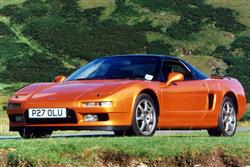SAYONARA FERRARI-SAN (some text hidden) --NONE--
BY ANDY ENRIGHT
Introductionword count: 116
The Honda NSX is in many ways a landmark car. Sure, Japan had produced some fondly remembered sporting cars before it, most notably the Datsun 240Z and Toyota Celica GT4. However, nothing had come from the Orient to challenge the established supercar elite of Ferrari and Porsche. Not until Honda unveiled the NSX to an astonished press at the 1989 Tokyo Show. Here was a car that offered genuine supercar performance, wrapped up in a high-tech aluminium construction and offering a V6 engine with Honda's renowned VTEC valve technology. It also looked ready to go into production, unlike so many other show cars. Never again would the Japanese be dismissed as pretenders to the supercar crown.
Modelsword count: 10
Models Covered: (2 dr supercar 3.0, 3.2 petrol [NSX, NSX-T])
Historyword count: 327
Much was made of the trickle-down effect of Formula One technology into the engineering of the NSX. In truth, the car is anything but highly strung and this was both the car's unique selling point and its main criticism. Launched in the UK in December 1990 in 3.0-litre hardtop form, the NSX gained rave reviews for the benign and accessible nature of its performance and handling. There were also carpings that the car didn't feel as special as a (then) £55,000 car should - in effect it felt like a lower, wider Civic. Given the choice, most preferred the sense of occasion bestowed by a Porsche 911. An automatic option, dubbed the F-matic, was also available, but this penalised performance to an unacceptable level, and never sold in significant numbers in the UK. 0-60 in 7.5 seconds is not what people expect of their supercars. The NSX received some minor changes in 1994, with larger seven-spoke alloy wheels and a passenger airbag being fitted. The manual car also received electric speed-sensitive power steering. A more significant development was the introduction in 1995 of the NSX-T model with a lift out targa roof. Mechanically identical to the fixed-head cars, the NSX-T was available with a manual box or the F-matic system. The biggest change in the NSX's lifespan to date came in January 1998 when the range was revised. A 3.2-litre 280bhp engine and six-speed gearbox were introduced to all manual models - the F-matic soldiered on with the old 3.0-litre unit. There were also other upgrades to brakes and steering, a revised front spoiler and a more effective transponder immobiliser. Another revision was visited upon the car in early 2002 when pedestrian safety legislation spelt the end of the pop up headlamps, replaced instead by bulbous fixed pods. The interior was revised slightly and in 2003 a lightweight NSX Type-R sports model was developed for the Japanese market. Some examples subsequently found their way to these shores.
What You Getword count: 213
If the NSX had a decent boot, you could use it for the weekly shop. That may well belittle the efforts of Honda's engineers who spent many hours thrashing prototypes around Motegi and the Nurburgring, but it's perhaps the car's biggest compliment. Here was an exotic mid-engined supercar that didn't steam up, foul its plugs, or overheat in traffic, that would start first time every time with the minimum of drama, and which had acceptable all round visibility. This was something that took a bit of getting used to. The usual supercar routine of contorting into an ape-like driving position was similarly redundant. It was disappointingly normal. Having said that, the NSX could hold its own with virtually any car produced. The V6 VTEC engine deserves to be remembered as one of the great powerplants of all time. And that howl it produces as it approaches its redline is quite magnificent. Inside, the NSX's cabin is designed to perfectly accommodate two people - but don't expect space for much else. All right, so you could just about fit a weekend's luggage for two in the boot - but you'd have to be selective with your packing. Standard equipment on both fixed and open-topped models runs to air conditioning, leather trim and cruise control.
To see the full road test text contact us on 0330 0020 227
Pictures (high res disabled)


|
Scoring (subset of scores)
Category: Sporting Cars
| Performance | |
| Handling | |
| Comfort | |
| Space | |
| Styling, Build, Value, Equipment, Depreciation, Handling, Insurance and Total scores are available with our full data feed. | |



